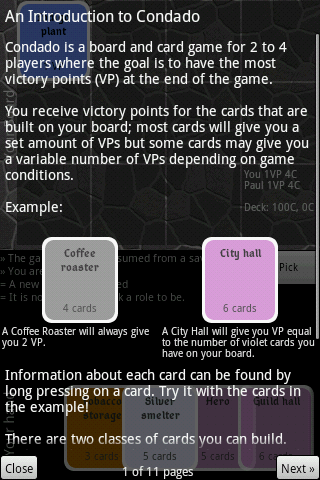San Juan isn’t a simple game. Actually (German) board games in general aren’t that easy to learn because you typically have to go through 10-something pages to learn the game mechanics. It’s not something you can just pick up and play. That fact basically kills the demographic for Condado because my target audience would be (% of people who enjoy German-style board games ) x (% of people who know how to play San Juan) x (% of people who own Android phones) x (% of people who hear about Condado) which would equal to about 50 people in the world.
My success would improve if I could teach people how to play Condado. That’s still a tough task because I don’t think you would want to squint and read 10 8.5×11″ pages on your phone! In the initial versions of Condado, I just included a weblink to a PDF of the rules, and provided a tutorial on how to use the UI. Thereby limiting my audience to people who knew how to play or wanted to read a PDF. That’s maybe 60 people.
I knew the next step was to include the rules in Condado, so I started writing up a more concise version. One good thing about a computerized version of the game is that the user doesn’t have to understand all of the game mechanics, the game will just do it for them. So they just need to know the premise and then learn through experimentation in the game environment. I fit the rules into about a page of words (which still ended up being 8 pages in Android world!) and went about implementing it.
As I was doing this, a thought hit me and I realized that I could make the rules interactive. Just prior to this, I added some functionality where a game could be saved and loaded. By leveraging that functionality, I could let the user play in a custom-built, deterministic scenario to learn the major points of the game. Great idea, I should pat myself on the back for that. And so I implemented it into Condado.

The tutorial is still mostly words that the user has to read through, but at certain points in the tutorial they will jump into the game and be forced to play through several actions. Then at the end of the tutorial, they can continue with the rest of the game if they wish.
I guess it’s just like a tutorial level in *real* games, but it’s cool that I could actually implement it without entirely breaking the game engine.
 Hi! and welcome to the eclectic personal blog of Kevin Quan. Come in, stay awhile, peek into the nooks & crannies, and learn a bit about me and my interests.
Hi! and welcome to the eclectic personal blog of Kevin Quan. Come in, stay awhile, peek into the nooks & crannies, and learn a bit about me and my interests.